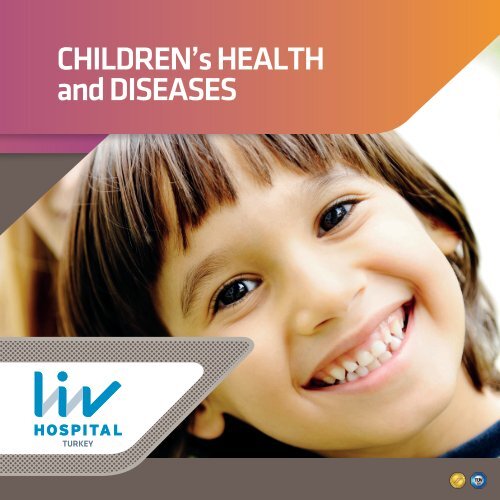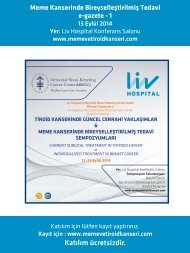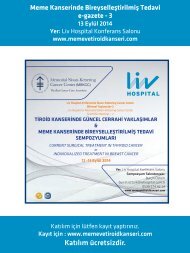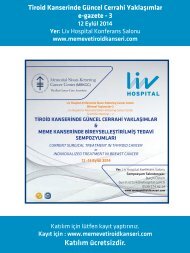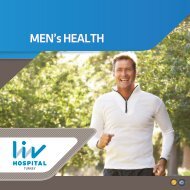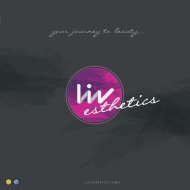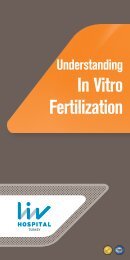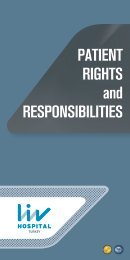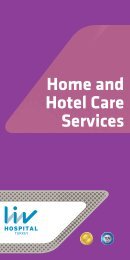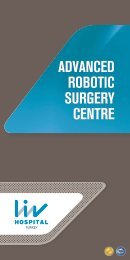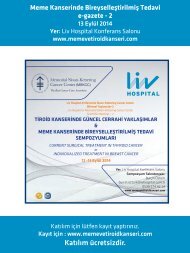CHILDREN’s HEALTH and DISEASES
You also want an ePaper? Increase the reach of your titles
YUMPU automatically turns print PDFs into web optimized ePapers that Google loves.
<strong>CHILDREN’s</strong> <strong>HEALTH</strong><br />
<strong>and</strong> <strong>DISEASES</strong><br />
TURKEY
C<br />
Our children are our greatest treasure…<br />
Our future<br />
Our greatest obligation towards our children<br />
is to build a healthy future for them with<br />
regular medical checkups <strong>and</strong><br />
compassionate parental care.<br />
Seeing our children healthy <strong>and</strong><br />
happy is life's greatest pleasure.
CONTENTS<br />
02<br />
Introduction<br />
05<br />
Neonatal Intensive Care Unit<br />
06<br />
07<br />
09<br />
11<br />
13<br />
15<br />
17<br />
19<br />
20<br />
Baby Rooms<br />
Monitoring At-risk Babies<br />
Children’s Allergies <strong>and</strong><br />
Asthma Department<br />
Pediatric Gastroenterology,<br />
Hepatology <strong>and</strong> Nutrition<br />
Pediatric Endocrinology<br />
Pediatric Cardiology<br />
Pediatric Hematology<br />
Pediatric Nephrology<br />
Pediatric Neurology<br />
23<br />
24<br />
25<br />
27<br />
28<br />
29<br />
31<br />
33<br />
35<br />
36<br />
Pediatric – Adolescent Psychiatry<br />
Pediatric Physical Treatment <strong>and</strong><br />
Rehabilitation<br />
Child Development<br />
Autism Clinic<br />
Language <strong>and</strong> Speech Pathology<br />
Genetik Danışmanlık<br />
Pediatric Skin Diseases<br />
Pediatric Oral <strong>and</strong> Dental Health<br />
Surgical Units<br />
Pediatric Orthopedics<br />
38<br />
41<br />
Pediatric Ear, Nose And Throat (Ent)<br />
Eye Diseases <strong>and</strong> Disorders<br />
42<br />
Pediatric Brain Surgery<br />
44<br />
Adolescent Gynecology
Liv Hospital treasures every living being that<br />
comes into the world. Our Pediatric<br />
Health <strong>and</strong> Disease Department offers<br />
individual treatments for all children<br />
development stages, from birth<br />
to adolescenece.<br />
In addition to having pediatrician specialists on 24-hour call,<br />
examinations are carried out at our polyclinic from 18.00-<br />
20.00 (6-8pm). Liv Hospital designed the Pediatric Health<br />
Department with children in mind, creating a fun <strong>and</strong><br />
kid-friendly atmosphere to ease anxiety of children visiting<br />
the hospital.<br />
Advanced diagnostic <strong>and</strong> treatment methods are implemented<br />
at the Liv Hospital Pediatric Health <strong>and</strong> Diseases Department<br />
for babies <strong>and</strong> children up to the age of 18. Patients are<br />
carefully assessed by experienced professors <strong>and</strong> specialists<br />
in line with current <strong>and</strong> joint scientific programs.<br />
Pediatric Health <strong>and</strong> Diseases Polyclinic offers a wide<br />
range of treatments for chest diseases, ıncluding allergies<br />
<strong>and</strong> Pediatric Gastroenterology <strong>and</strong> children heart care.<br />
Our polyclinic has been specially designed for children, an<br />
entertaining space that helps children overcome their fear<br />
of doctors. A fully-equipped breast feeding room is at the<br />
service of waiting mothers <strong>and</strong> an observation room set<br />
aside to keep sick babies <strong>and</strong> children under observation<br />
<strong>and</strong> to perform short-term treatments.
03 | <strong>CHILDREN’s</strong> <strong>HEALTH</strong> <strong>and</strong> <strong>DISEASES</strong><br />
Patients’ laboratory tests are taken by an experienced<br />
pediatric nurse at our polyclinic.<br />
All our doctors are always accessible for the monitoring of<br />
healthy children (vaccinations, nutrition, growth <strong>and</strong><br />
development) as well as children who are ill.<br />
Every baby born at our hospital receives one home visit<br />
from our Home Care Services unit after their discharge<br />
from hospital, to assess their individual condition <strong>and</strong><br />
needs.<br />
Monthly check-ups of babies born at our hospital are<br />
carried out, with free of charge development tests by a<br />
pediatric specialist up to the age of one year. Objective<br />
testing is carried out by our child development experts in<br />
order to evaluate children’s mental <strong>and</strong> physical development<br />
according to their age.<br />
Other concerned medical departments <strong>and</strong> branches are<br />
coordinated to provide all required scanning during the<br />
period of observation (eye tests, dental tests etc.).
NEONATAL<br />
INTENSIVE CARE UNIT<br />
Liv Hospital is fully-equipped with high technology neonatal Intensive Care Unit (ICU)<br />
offering medical <strong>and</strong> nursing care, delivered 24-hours a day by dedicated neonatologists<br />
<strong>and</strong> a compassionate nursing team. The ICU boasts 8 incubators, <strong>and</strong> 1 ventilator<br />
which can be used for alternative methods (HFO).<br />
In order to minimize the risk of infection <strong>and</strong> to provide the best possible<br />
treatment, each infant is placed in a safe room outfitted with<br />
state-of-the-technology to ensure that your infant will receive the highest<br />
level of care possible.<br />
The purpose of Liv Hospital Neonatal Unit is to provide the safest <strong>and</strong><br />
most efficient development care for our newborns <strong>and</strong> support for<br />
parents.<br />
The Neonatal Intensive Unit is staffed by one of our doctors<br />
(on call for 24 hours) who has special training in newborn<br />
care. The NIU is aslo fully-equipped with the latest<br />
equipment <strong>and</strong> advanced appliances to deliver the<br />
best neonatal care in Turkey <strong>and</strong> provide timely<br />
emergency intervention when needed.<br />
Very close observation is made to monitor babies’<br />
respiration, circulation, nutrition <strong>and</strong> infection problems,<br />
to implement the most appropriate treatment <strong>and</strong><br />
to address any problems as they arise.<br />
Our specialists are also available to supervise the transfer of<br />
babies with health problems from other hospitals.<br />
Liv Hospital offers home care services for babies following their<br />
discharge from the neonatal unit after a period of monitoring<br />
<strong>and</strong> follow-up. Our unit has 8 incubators, 2 of which can be used<br />
as open heated cots, with individual rooms for each baby.
05 | <strong>CHILDREN’s</strong> <strong>HEALTH</strong> <strong>and</strong> <strong>DISEASES</strong><br />
TECHNICAL FEATURES of<br />
THE NEONATAL UNIT<br />
Every bed has an EKG, respiration, pulse oximeter, with<br />
additional monitors for invasive <strong>and</strong> blood pressure.<br />
There are 4 ventilators with nasal / endotracheal CPAP,<br />
SIMV, pressure <strong>and</strong> volume controlled ventilation, <strong>and</strong><br />
high frequency ventilation equipment<br />
Phototherapy<br />
Baby-specific mother’s milk bank<br />
Blood gas analysis <strong>and</strong> capillary electrolytes<br />
Portable X-ray, ultrasound <strong>and</strong> echocardiograph equipment<br />
Transportable ventilator, special incubator <strong>and</strong> monitors<br />
All patients in our unit have their data measured (vital<br />
functions, monitor analysis, ventilator readings, medication<br />
applications etc.) with this data digitally monitored so<br />
that it can be read <strong>and</strong> followed within the hospital or<br />
outside by means of mobile telephones.<br />
PROCEDURES CARRIED OUT<br />
IN THE NEONATAL UNIT<br />
Installation of umbilical catheters<br />
Thoracic drainage<br />
Lumbar puncture<br />
Endotracheal intubation<br />
Surfactant application<br />
Post-op follow-up<br />
Partial <strong>and</strong> total blood exchange<br />
Total parenteral nutrition<br />
Phototherapy<br />
Percutaneous insertion of silastic catheter<br />
Newborn circumcision<br />
OUR NEONATAL TEAM<br />
Specialist doctors are on call 24 hours a day for diagnostic<br />
<strong>and</strong> treatment at the unit.<br />
Pediatric surgery, pediatric neurology, pediatric cardiology,<br />
cardiovascular surgery, retina <strong>and</strong> brain surgery specialists<br />
support the Unit’s dedicated treatment team.<br />
Our nurses are specially trained in neonatal intensive care<br />
<strong>and</strong> resuscitation.<br />
The hospital’s infection control committee composed of<br />
doctors <strong>and</strong> nurses continuously monitor <strong>and</strong> control the<br />
Unit with strictly kept records.<br />
Our mission is to provide all our babies with the best natal<br />
<strong>and</strong> post-natal care for the best possible outcomes for a<br />
healthy <strong>and</strong> happy new generation.
BABY ROOMS<br />
Every birth is accompanied by the close involvement of<br />
pediatric health <strong>and</strong> disease specialists. Prior to discharge,<br />
every newborn requires to be screened <strong>and</strong> to undergo<br />
essential examinations such as hearing tests, jaundice,<br />
hypothyroidism, phenylke-tonuria <strong>and</strong> metabolic disease<br />
screening.<br />
Our baby nurse pays a home visit during the 48-hour<br />
period following the baby’s discharge. Other health tests<br />
<strong>and</strong> check-ups are carried out during the first week at the<br />
Pediatric Health Clinic. In the first hours after birth, minor<br />
or temporary issues can generally be addressed in the<br />
baby's room. High-risk cases <strong>and</strong> childbirth problems are<br />
purposefully treated in the Neonatal ICU.<br />
M<br />
H<br />
We are proud to be a baby-friendly hospital. Mother's milk is the best form of<br />
nutrition for babies. That’s why we strongly encourage mothers to<br />
begin breastfeeding as soon as they <strong>and</strong> their baby are in a healthy condition.<br />
Every possible support is given to mother <strong>and</strong> baby during this period.<br />
Counseling on breastfeeding is given.
07 | <strong>CHILDREN’s</strong> <strong>HEALTH</strong> <strong>and</strong> <strong>DISEASES</strong><br />
MONITORING<br />
HIGH-RISK BABIES<br />
.<br />
.<br />
.<br />
The monitoring <strong>and</strong> care of high-risk cases such as premature<br />
births, multiple births, babies whose mothers have<br />
diabetes, large babies, babies who have swallowed meconium<br />
in the womb, <strong>and</strong> brain or other damage that results<br />
in difficult births, is different from the monitoring carried<br />
out in normal births.<br />
These cases involve the risk of issues such as respiratory<br />
problems, chronic lung disease, jaundice, feeding difficulties,<br />
intracranial bleeding <strong>and</strong> Retinopathy of Prematurity<br />
(eye disease in newborns). The monitoring of high-risk<br />
babies is conducted by specialists in the field.<br />
Developmental tests are carried out at our High-Risk Baby<br />
Clinic in order to follow development closely; there are far<br />
better outcomes when early diagnosed issues are addressed<br />
with early physical treatment. Multidisciplinary<br />
monitoring <strong>and</strong> treatment is also provided by various<br />
other Liv Hospital departments such as the Eye, Audiology<br />
<strong>and</strong> Speech Therapy Departments. Special attention<br />
is paid to the nutrition of premature births or babies who<br />
have undergone extended ICUhospitalization, in order to<br />
ensure that they reach height <strong>and</strong> weight objectives in<br />
later years.<br />
During this period special applications such as the fortification<br />
of mother’s milk, high-calorie foodstuffs <strong>and</strong> tube<br />
feeding are implemented as <strong>and</strong> when required.<br />
A vaccination program known as a “Cocoon Strategy” is<br />
implemented, ensuring that all those in regular contact<br />
with the baby (parents & relatives, nannies <strong>and</strong> health<br />
workers) are protected with vaccines for tetanus, adult<br />
diphtheria <strong>and</strong> adult acellular pertussis. Additional protection<br />
against endemic <strong>and</strong> p<strong>and</strong>emic diseases is given by<br />
ensuring that as well as the baby, those who come in to<br />
contact with the baby are vaccinated against influenza.<br />
Premature births <strong>and</strong> those with chronic lung or cardiologic<br />
disease who are prone to RSV (respiratory syncytial<br />
virus) are also at higher risk of severe lower respiratory<br />
disease. For this reason, children born between the<br />
months of October <strong>and</strong> March are provided with extra<br />
antibody (synagis) protection.
<strong>CHILDREN’s</strong><br />
ALLERGIES AND<br />
ASTHMA DEPARTMENT
09 | <strong>CHILDREN’s</strong> <strong>HEALTH</strong> <strong>and</strong> <strong>DISEASES</strong><br />
The number of children suffering from allergies is continuously<br />
on the rise. Research shows that one in every 6-7<br />
children has asthma, one in 10 allergic rhinitis <strong>and</strong> one in<br />
20 eczema. The annual increase in rates is not limited to<br />
one country but is seen throughout the world. The main<br />
forms of allergy cases are asthma (allergic bronchitis),<br />
wheezy infant, allergic rhinitis, eczema, food allergy,<br />
urticaria (hives), allergy to medication <strong>and</strong> bee-sting<br />
allergy.<br />
Symptoms of frequent coughing, shortness of breath <strong>and</strong><br />
wheezing may well indicate asthma; repeated sneezing,<br />
runny, itchy <strong>and</strong> blocked, allergic rhinitis, while facial rash<br />
or redness that begins in infancy <strong>and</strong> develops below the<br />
neck with itching at the joints probably signifies eczema.<br />
You should consult an allergy specialist if your child shows<br />
any of these symptoms.<br />
The most efficient method to diagnose these conditions<br />
is to use skin allergy tests. However, these tests are not<br />
sufficient on their own. Your child’s symptoms <strong>and</strong> test<br />
results must be thoroughly assessed by an allergy specialist<br />
at Liv Hospital in order to reach an accurate diagnosis.<br />
A pediatric allergy specialist is a doctor trained in the<br />
diagnosis, treatment <strong>and</strong> follow-up of allergy cases such<br />
as asthma, allergic rhinitis, wheezing children, eczema,<br />
hives skin allergies, eye allergy, food allergy, drug allergy,<br />
insect allergy, occupational allergies, allergic shock <strong>and</strong><br />
hereditary angioedema in children from birth to adolecence<br />
stages. Allergic diseases are known for their onset<br />
nature; they may happen all at once. Asthmas, for example,<br />
are closely associated with allergic rhinitis. Children<br />
with eczema often have food allergies. Pediatric allergy<br />
specialists care for allergy cases as a whole.<br />
Skin allergy patch testing <strong>and</strong> respiration function testing<br />
is carried out by specialists at the Pediatric Allergy <strong>and</strong><br />
Asthma Unit.<br />
Blood allergy tests, sweat tests <strong>and</strong> asthma monitoring (nitric oxide levels in the breath)<br />
testing, are carried out at Liv Hospital.<br />
Moreover, Liv Hospital has the capacity to undertake all necessary radiologic <strong>and</strong><br />
nuclear medicine tests.<br />
Parents can breathe a sigh of relief at the extensive <strong>and</strong><br />
advanced expertise used for diagnosis <strong>and</strong> treatment at<br />
Liv Hospital Pediatric Allergy <strong>and</strong> Asthma Unit.
PEDIATRIC CHEST DISEASE UNIT<br />
Our Pediatric Chest Disease Unit diagnoses <strong>and</strong> treats a<br />
wide range of respiratory diseases <strong>and</strong> lung conditions,<br />
including cystic fibrosis, pneumonia, recurrent pneumonia,<br />
chronic lung diseases, bronchopulmonary dysplasia in<br />
premature birth lung problems, bronchiectasis,<br />
long-lasting cough, recurrent interstitial lung disease,<br />
<strong>and</strong> sleep problems.<br />
Radiology is crucial in the diagnosis of pediatric chest<br />
diseases. Liv Hospital employs the most advanced<br />
radiologic technology <strong>and</strong> trained specialists to ensure<br />
correct diagnosis <strong>and</strong> treatment.<br />
The Department carries out respiratory function tests,<br />
sweat tests, <strong>and</strong> genetic analysis testing for cystic<br />
fibrosis.
11 | <strong>CHILDREN’s</strong> <strong>HEALTH</strong> <strong>and</strong> <strong>DISEASES</strong><br />
PEDIATRIC<br />
GASTROENTEROLOGY,<br />
HEPATOLOGY AND NUTRITION<br />
In addition to the diagnosis <strong>and</strong> treatment of all pediatric<br />
<strong>and</strong> adolescent development stages diseases of the<br />
digestive system from birth to 18 years old (the esophagus,<br />
stomach, duodenum, <strong>and</strong> the small <strong>and</strong> large intestine),<br />
liver <strong>and</strong> bile duct diseases, our Pediatric Gastroenterology,<br />
Hepatology <strong>and</strong> Nutrition Department represents<br />
a sub-branch of medicine that is also equipped to provide<br />
specialist nutrition advice <strong>and</strong> support to both healthy<br />
children <strong>and</strong> to those with chronic diseases that require<br />
particular dietary measures <strong>and</strong> care.<br />
PEDIATRIC GASTROENTEROLOGY,<br />
HEPATOLOGY AND NUTRITION DIAGNOSIS<br />
(COMMON SYMPTOMS):<br />
• Chronic / recurrent abdominal pain<br />
• Vomiting<br />
• Diarrhea, bloody diarrhea<br />
• Weight gain, abdominal distension<br />
• Constipation<br />
• Digestive tract bleeding<br />
(black-colored stool, vomit that resembles ground coffee)<br />
• Unexplained growth retardation<br />
• Pathology <strong>and</strong> treatment-resistant anemia<br />
• Fatty Liver disease (obesity)<br />
• Jaundice<br />
• Elevated levels in Liver tests<br />
• Ingestion of foreign material / caustic substance ingestion
COMMON <strong>DISEASES</strong> OF PEDIATRIC<br />
GASTROENTEROLOGY,<br />
HEPATOLOGY AND NUTRITION:<br />
• Gastroesophageal reflux disease (GERD)<br />
• Corrosive esophagitis<br />
• Gastritis (acute <strong>and</strong> chronic)<br />
• Germ-related Helicobacter pylori gastritis<br />
• Ulcer, dyspepsia (indigestion)<br />
• Chronic diarrhea <strong>and</strong> stunted growth<br />
• Celiac (Coeliac) disease<br />
• Constipation<br />
• Bloody stool, growth retardation <strong>and</strong> colitis<br />
(ulcerative colitis, Crohn's disease)<br />
• Polyps<br />
• Hepatitis <strong>and</strong> jaundice (hepatitis B, C, D & E)<br />
• Autoimmune hepatitis<br />
• Wilson's disease<br />
• Biliary tract <strong>and</strong> gall bladder disease<br />
• Pancreatic diseases<br />
• Food allergies (including allergies to cow's milk)<br />
• Loss of appetite, obesity<br />
• Nutritional support (disease-specific nutrition)<br />
P<br />
DIAGNOSTIC AND TREATMENT PROCEDURES CARRIED OUT<br />
BY THE PEDIATRIC GASTROENTEROLOGY DEPARTMENT:<br />
1. Diagnostic endoscopy<br />
Esophagogastroduodenoscopy<br />
Sigmoidoscopy<br />
Colonoscopy<br />
2. Therapeutic / treatment endoscopic procedures<br />
Varicose endoscopic b<strong>and</strong> ligation<br />
Polypectomy<br />
Dilation of esophageal stenosis<br />
Percutaneous endoscopic gastrostomy<br />
3. Liver biopsy<br />
4. 24-hour pH monitoring<br />
5. 13C urea breathing test
13 | <strong>CHILDREN’s</strong> <strong>HEALTH</strong> <strong>and</strong> <strong>DISEASES</strong><br />
lk)<br />
PEDIATRIC ENDOCRINOLOGY<br />
)<br />
Liv Hospital Pediatric Endocrinology Department specializes<br />
in the diagnosis, treatment <strong>and</strong> monitoring of endocrinological<br />
problems such as growth retardation, short<br />
stature, early puberty, delayed puberty, diabetes, hypoglycemia<br />
(low blood sugar), obesity, thyroid <strong>and</strong> thyroid<br />
gl<strong>and</strong> disorders (hypothyroidism-hyperthyroidism), sexual<br />
development disorders, penile problems, adrenal gl<strong>and</strong><br />
disorders, irregular periods, excessive hair growth, pituitary<br />
gl<strong>and</strong> disorders, Turner's Syndrome, vitamin D-related<br />
disorders, calcium <strong>and</strong> phosphorus metabolism disorders,<br />
<strong>and</strong> various bone complaints especially rickets.<br />
PROCEDURES CARRIED OUT BY THE<br />
PEDIATRIC ENDOCRINOLOGY<br />
DEPARTMENT:<br />
Liv Hospital carries out all dynamic endocrinological tests<br />
(growth hormone stimulation, sugar load tests etc.)<br />
required for the correct these types of diseases. All babies<br />
born at Liv Hospital undergo hyperthyroid screening in<br />
cooperation with our Neonatal Unit.<br />
DIAGNOSTIC AND TREATMENT TESTS<br />
CARRIED OUT AT THE PEDIATRIC<br />
ENDOCRINOLOGY DEPARTMENT:<br />
Hormonal stimulation <strong>and</strong> suppression tests<br />
Analysis of body fat in children<br />
Analysis of bone mineral density in children<br />
Hypothyroidism screening<br />
Growth hormone stimulation tests<br />
Tests in early adolescence<br />
Bone age determination
PEDIATRIC CARDIOLOGY
15 | <strong>CHILDREN’s</strong> <strong>HEALTH</strong> <strong>and</strong> <strong>DISEASES</strong><br />
Pediatric heart diseases are divided into two groups –<br />
hereditary <strong>and</strong> acquired. Rhythm disorders are evident in<br />
both these groups. 8 in 1.000 babies suffer from some<br />
kind of hereditary heart condition. The most common<br />
acquired heart diseases is acute rheumatic fever.<br />
ADVANCED DIAGNOSTICS AT THE<br />
PEDIATRIC CARDIOLOGY DEPARTMENT:<br />
Heart electrocardiogram (ECG)<br />
Heart X-ray (Telecardiography)<br />
Cardiac ultrasonography (Color Doppler echocardiography)<br />
Cardiac catheterization <strong>and</strong> angiography<br />
24-hour ECG monitoring rhythm disorders (Holter ECG),<br />
Advanced diagnostic methods are used, including<br />
electrophysiological employed
PEDIATRIC HEMATOLOGY
17 | <strong>CHILDREN’s</strong> <strong>HEALTH</strong> <strong>and</strong> <strong>DISEASES</strong><br />
The diagnosis <strong>and</strong> treatment of all types of blood- <strong>and</strong><br />
blood product-related disease is carried out in our Pediatric<br />
Hematology Unit.<br />
All anemias (iron deficiency anemia, vitamin B12 deficiency<br />
anemia), congenital blood disorders (thalassemia,<br />
sickle cell anemia <strong>and</strong> other abnormal hemoglobins),<br />
bone marrow failure (aplastic anemia, Fanconi aplastic<br />
anemia, Diamond-Blackfan anemia), idiopathic thrombocytopenic<br />
purpura neutropenia, childhood leukemia,<br />
bleeding diathesis, coagulation disorders (hemophilia A),<br />
are treated <strong>and</strong> diagnosed by a team of experienced<br />
pediatric hematology specialists.
PEDIATRIC NEPHROLOGY
19 | <strong>CHILDREN’s</strong> <strong>HEALTH</strong> <strong>and</strong> <strong>DISEASES</strong><br />
The treatment <strong>and</strong> diagnosis if pediatric kidney <strong>and</strong> urinary<br />
system disorders <strong>and</strong> rheumatic diseases is carried out at this<br />
dedicated Liv Hospital unit.<br />
The main disorders treated are: urinary tract infections, glomerulonephritis,<br />
hematuria, vesicoureteral reflux (VUR), antenatal<br />
hydronephrosis, urinary tract stones, urinary tract obstruction<br />
(UPD, UVD), urinary incontinence, hemolytic uremic syndrome,<br />
Henoch-Schönlein purpura, familial Mediterranean fever (FMF),<br />
wetting (enuresis), <strong>and</strong> hypertension.
20 | <strong>CHILDREN’s</strong> <strong>HEALTH</strong> <strong>and</strong> <strong>DISEASES</strong><br />
PEDIATRIC NEUROLOGY<br />
Pediatric neurology is a multidisciplinary branch of<br />
medical science that aims to prevent, reduce, diagnose<br />
<strong>and</strong> treat neurologic issues, <strong>and</strong> to ensure a better quality<br />
of life for children suffering from neurologic disorders. The<br />
continuously developing nervous system can be damaged<br />
during pregnancy, during or after childbirth. As a result of<br />
this, or hereditary disorders, various conditions can arise<br />
such as cerebral palsy (paralysis of the brain), epilepsy,<br />
mental retardation, movement disorders, autism, muscular<br />
diseases, as well as spinal cord <strong>and</strong> peripheral nerve<br />
disorders. These conditions can affect the child throughout<br />
his or life, <strong>and</strong> in some cases limit their lifespan.<br />
A child is developed as one entity. Disorders of other<br />
systems <strong>and</strong> organs can impact the child’s nervous<br />
system as well. Emergency neurologic situations are not<br />
uncommon in children; the most frequent of these are<br />
coma, paralysis or strokes, <strong>and</strong> febrile as well as<br />
non-febrile seizures that can cause lasting damage <strong>and</strong> in<br />
extreme cases even be fatal.
Advanced EEG records of babies <strong>and</strong> children are kept<br />
in special archives at Liv Hospital, which are thoroughly<br />
evaluated by experienced pediatric neurology<br />
specialists. In addition to EEG tests, BT <strong>and</strong> MR scan<br />
tests are also carried out for children of all ages.
PEDIATRIC –<br />
ADOLESCENT<br />
PSYCHIATRY<br />
Liv Hospital’s Pediatric – Adolescent Psychiatry Clinic<br />
offers psychiatric <strong>and</strong> psychological care services for<br />
children <strong>and</strong> adolescents up to the age of 18. Detailed<br />
psychiatric <strong>and</strong> developmental evaluations are carried out<br />
by our Clinic’s pediatric / adolescent psychiatrists.<br />
Following further clinicalpsychological tests, the nature<br />
<strong>and</strong> probable underlying causes of the patient’s emotional,<br />
behavioral, social <strong>and</strong> academic issues are determined.<br />
A multidisciplinary team of clinical psychologists, child<br />
development specialists <strong>and</strong> speech therapists<br />
well-trained <strong>and</strong> experienced in the field of pediatric /<br />
adolescentpsychology work h<strong>and</strong> in h<strong>and</strong> to provide care<br />
<strong>and</strong> treatment at the Clinic.<br />
This teamwork allows for management of a strict<br />
treatment protocol for each of our young patients.<br />
Our experts provide invaluable counseling on the psychological<br />
state of children <strong>and</strong> adolescents who suffer from<br />
development issues. Training groups <strong>and</strong> seminar<br />
programs are offered in the clinic's preventive psychological<br />
healthcare services. Children <strong>and</strong> adolescents who are<br />
treated at Liv Hospital, <strong>and</strong> their loved ones, benefit from<br />
a high level of care <strong>and</strong> support from a multidisciplinary<br />
team of specialists in pediatric medicine <strong>and</strong> a number of<br />
other fields of medical specialization.
23 | <strong>CHILDREN’s</strong> <strong>HEALTH</strong> <strong>and</strong> <strong>DISEASES</strong>
PEDIATRIC<br />
PHYSICAL TREATMENT<br />
AND REHABILITATION<br />
Pediatric rehabilitation applies physiotherapeutic<br />
methods designed to eradicate challenges <strong>and</strong> difficulties<br />
experienced by children caused by physical, sensory or<br />
cognitive disorders originating in the natal or post-natal<br />
stages. As well as helping to develop motor skills, balance,<br />
coordination, strength <strong>and</strong> endurance, this achieves<br />
development of the integration of cognitive <strong>and</strong> sensory<br />
processes.<br />
This also serves to help children with physical disabilities<br />
attain their maximum physical performance through their<br />
daily lives. These care services are dedicated to age-appropriate<br />
development steps (e.g. crawling, sitting,<br />
st<strong>and</strong>ing <strong>and</strong> walking), basic motor skills, improving<br />
breadth of movement <strong>and</strong> peer participation in school<br />
activities, as well as the development of strength,<br />
mobility, posture, equilibrium <strong>and</strong> endurance.
25 | <strong>CHILDREN’s</strong> <strong>HEALTH</strong> <strong>and</strong> <strong>DISEASES</strong><br />
CHILD DEVELOPMENT<br />
As well as arranging training programs devoted to the<br />
intellectual, linguistic, motor, self-care, social <strong>and</strong> emotional<br />
development of children up to the age of 18, we offer<br />
counseling guidance to parents on relationship issues with<br />
their children.<br />
Developmental Support for Healthy Children<br />
Baby growth <strong>and</strong> development (social, mental, speech<br />
<strong>and</strong> mobility)<br />
Monitoring of high-risk babies (premature births, babies<br />
in intensive care etc.)<br />
Selection of games <strong>and</strong> play activities appropriate to<br />
development<br />
Regulation of children’s eating, sleeping <strong>and</strong> toilet habits<br />
Intra-sibling relationships<br />
Behavioral disorders (bed wetting, nail-biting,<br />
thumb-sucking, temper tantrums, defiance etc.)<br />
Determining the right age for the child to attend crèche<br />
or primary school<br />
Clinical Support for Children with<br />
Developmental Problems<br />
Pervasive developmental disorders <strong>and</strong> autism<br />
Outst<strong>and</strong>ing <strong>and</strong> gifted children<br />
Children with language <strong>and</strong> speech problems<br />
(stuttering, delayed speech etc.)<br />
Children with attention-deficit hyperactivity disorder,<br />
learning disabilities <strong>and</strong> intellectual disabilities<br />
Children with hearing, neurological, genetic <strong>and</strong> metabolic<br />
disorders<br />
Supporting developmental skills in children in hospital<br />
or with long-term health problems
AUTISM CLINIC<br />
The first people to suspect that a child is autistic are the<br />
child’s parents, doctors, loved ones <strong>and</strong> teachers. Some<br />
families who notice a problem in the child’s development<br />
may ignore these early signs, dismissing the condition as<br />
temporary or not serious to see a specialist. However the<br />
most important factor in the future pace of the disorder<br />
is early diagnosis. Autism is classified as an emergency<br />
disorder in the field of psychiatry. For a definitive<br />
diagnosis, the child’s detailed developmental history,<br />
psychological evaluation, observation of symptoms,<br />
determination of whether there is any other medical or<br />
psychiatric condition, <strong>and</strong> an investigation into underlying<br />
causes, are required.<br />
Recent research indicates that the preparation <strong>and</strong><br />
implementation by trained specialists of individualized<br />
education programs that take account of the diagnosed<br />
child’s individual skills <strong>and</strong> needs remains the most<br />
effective method of treatment. As well as the professional<br />
treatment team consisting of psychiatrists, clinical<br />
psychologists, pediatric neurologists, pediatricians,<br />
special needs education experts <strong>and</strong> speech therapists,<br />
everyone who is in social contact with the child -<br />
including family <strong>and</strong> teachers – form an integral part in<br />
setting up the action plan. Proper coordination within the<br />
team is of crucial importance to offer an effective<br />
treatment plan.
27 | <strong>CHILDREN’s</strong> <strong>HEALTH</strong> <strong>and</strong> <strong>DISEASES</strong><br />
Pediatric Psychiatrist<br />
Autism diagnosis <strong>and</strong> etiologic studies are carried out by a<br />
pediatric psychiatrist who is responsible for monitoring<br />
the development of the condition, evaluating possible<br />
supplementary psychiatric diagnoses, <strong>and</strong> treatment.<br />
Clinical Psychologist<br />
Special Needs Learning Specialist<br />
Special Needs Learning Specialists are trained to evaluate<br />
<strong>and</strong> aid children with learning disabilities. They work with<br />
the child, the parent, to develop strategies to compensate<br />
for any learning deficits. They often work with children<br />
one-on-one to develop a learning program that suits the<br />
special needs of the child.<br />
A clinical psychologist carries out the necessary developmental<br />
tests on children diagnosed with autism. The<br />
clinical psychologist also provides psychological support to<br />
the child <strong>and</strong> family to assist in overcoming communication<br />
issues throughout the treatment phase.<br />
Pediatrician<br />
Pediatric Neurologist<br />
Autism is a neurodevelopmental disorder. Pediatric neurologist<br />
has a special training <strong>and</strong> experience to treat<br />
children suffering from neurological problems such as<br />
seizures, delayed speech, epilepsy, weakness or headaches.<br />
Our pediatric neurologist advanced training <strong>and</strong><br />
experience equip them to meet your child’s unique needs.<br />
Pediatricians manage the physical, mental, <strong>and</strong> emotional<br />
well-being of their pediatric patients, in every stage of<br />
development - in good health or in illness.<br />
Speech Therapist<br />
Autism impacts the child’s linguistic <strong>and</strong> communication<br />
abilities. Speech therapy assesses <strong>and</strong> treats speech,<br />
language <strong>and</strong> communication problems in children to help<br />
them better communicate. Speech therapy is an essential<br />
part of autism treatment plan as it plays a great role in<br />
determining the child’s ability to underst<strong>and</strong> <strong>and</strong> articulate<br />
the language effectively.
28 | <strong>CHILDREN’s</strong> <strong>HEALTH</strong> <strong>and</strong> <strong>DISEASES</strong><br />
Speech, language <strong>and</strong> swallowing disorders can be caused<br />
by hearing loss, mental disability, autism, Down syndrome,<br />
brain injury, stroke, neurological problems, cleft lip-palate,<br />
mouth, head <strong>and</strong> neck cancers, or other genetic or medical<br />
disorders. These disorders can be hereditary or the result of<br />
accident or injury. The cause is not always determinable.<br />
The Liv Hospital Speech <strong>and</strong> Language Pathology Clinic is<br />
devoted to providing healthcare services in the following<br />
areas:<br />
• The diagnosis of speech, articulation <strong>and</strong> fluency<br />
disorders, sound quality related problems (disorders of<br />
articulation / phonological disorders / apraxia / dysarthria<br />
/ stuttering / audio disease) <strong>and</strong> their treatment by<br />
means of game-based speech therapy exercises.<br />
• The diagnosis <strong>and</strong> severity assessment of difficulties in<br />
underst<strong>and</strong>ing spoken <strong>and</strong> written language or other<br />
forms of expression (like sign language), <strong>and</strong> its<br />
treatment by means of game-based therapies <strong>and</strong><br />
treatments that support language development.<br />
• The endoscopic <strong>and</strong>/or radiologic examination of feeding<br />
<strong>and</strong> swallowing problems caused by illness, surgery,<br />
stroke or injury, <strong>and</strong> their treatment by means of various<br />
methods of therapy.<br />
LANGUAGE AND<br />
SPEECH PATHOLOGY
GENETIC COUNSELING<br />
Genetic counseling helps to create highly individualized<br />
treatment plans benefiting from the latest advances in<br />
medical <strong>and</strong> genetic technology. Especially in cases of<br />
genetically predisposed individuals (those who have a<br />
family history of genetic disorders), genetic counseling<br />
has a significant role. Such individuals can benefit from<br />
genetic counseling by finding out what genetic issues<br />
may or may not apply to their particular cases, <strong>and</strong> what<br />
health issues may occur as a result of these factors.<br />
Genetic counselors guide patients with regard to the<br />
treatment of the disorders to which they are genetically<br />
predisposed. Parents whose unborn child is diagnosed as<br />
being exposed to genetic issues may also seek genetic<br />
counseling in gaining scientific, accurate <strong>and</strong> objective<br />
information about the likely course of the pregnancy.<br />
CANDIDATES FOR PARENTAL<br />
GENETIC COUNSELING<br />
Prospective mothers over the age of 33<br />
Prospective mothers who have had anomalies detected<br />
in previous pregnancy<br />
Couples with a family history of genetic disorders or<br />
diseases<br />
Prospective mothers who have undergone previous<br />
miscarriage(s)
PEDIATRIC<br />
SKIN <strong>DISEASES</strong>
31 | <strong>CHILDREN’s</strong> <strong>HEALTH</strong> <strong>and</strong> <strong>DISEASES</strong><br />
Liv Hospital’s Department of Pediatric Dermatology is<br />
dedicated to the diagnosis <strong>and</strong> treatment of dermatologic<br />
complaints in babies <strong>and</strong> young adults of all ages, through<br />
childhood to adolescence. All kinds of pediatric skin<br />
problems are dealt with at the Department, which<br />
diagnoses, monitors <strong>and</strong> treats hereditary skin diseases<br />
such as ichthyosis, epidermolysis bullosa, genodermatoses,<br />
etc.<br />
Testing <strong>and</strong> treatment is carried out on allergic skin<br />
eczemas in children (atopic dermatitis)<br />
Hair complaints in children (alopecia areata, hereditary<br />
hair problems, etc.) is diagnosed <strong>and</strong> treated<br />
The diagnosis <strong>and</strong> treatment of commonly observed<br />
warts on children is carried out (electrocautery, cryocautery,<br />
laser treatment.)
Liv Hospital Oral <strong>and</strong> Dental Health Clinic educates<br />
children in effective preventive methods of oral <strong>and</strong><br />
dental hygiene <strong>and</strong> care, including cavity prevention<br />
methods such as fissure sealant <strong>and</strong> fluoride applications.<br />
Additionally, Cavity Analysis Tests helps to detect the<br />
child’s tendency to develop cavities by providing data on<br />
bacteria counts in the saliva, oral hygiene <strong>and</strong> eating<br />
habits. This test is part of an extensive treatment plan<br />
designed to minimize or eradicate cavity development. In<br />
addition, These tests are carried out on younger children<br />
to determine future deficiencies <strong>and</strong> dental disorders that<br />
may prompt the need for orthodontic treatment, as the<br />
child goes into puberty <strong>and</strong> adolescence.<br />
PEDIATRIC ORAL<br />
AND DENTAL <strong>HEALTH</strong>
33 | <strong>CHILDREN’s</strong> <strong>HEALTH</strong> <strong>and</strong> <strong>DISEASES</strong><br />
Filings <strong>and</strong> Canal Treatment<br />
Placeholders<br />
Just as adults, children can develop cavities <strong>and</strong> other<br />
dental issues which are effectively treated by dental<br />
fillings <strong>and</strong> root canal procedures to leave your mouth free<br />
of cavity <strong>and</strong> with a perfect smile. Treatment carried out<br />
on milk teeth also helps to prevent infection <strong>and</strong> the<br />
emergence of healthy adult teeth.<br />
Placeholders are used to fill the place of teeth that have<br />
been extracted because they were damaged beyond repair<br />
or for other reasons, preserving the space for the emergence<br />
of Development of permanent teeth; this prevents<br />
future crowding <strong>and</strong> other dental issues.<br />
Dental Trauma Treatment<br />
Dental Treatment Under<br />
General Anesthetic or Sedation<br />
Broken, chipped, or lost teeth are common in children as a<br />
result of falls or an accident; wobbly teeth can also be a<br />
problem. Dental trauma can be effectively treated by the<br />
most advanced technology <strong>and</strong> innovative techniques.<br />
Our clinic <strong>and</strong> operating room is able to treat children<br />
under the age of 4 who have a fear of treatment as the<br />
result of previous experience, or who cannot undergo<br />
treatment normally due to health problems, with general<br />
anesthetic or sedation.<br />
Orthodontics (Dental Correction)<br />
Orthodontics is the branch of dental medicine dealing with<br />
the correction of irregularities to dental <strong>and</strong> jaw structure<br />
<strong>and</strong> development. Orthodontists often use corrective<br />
devices such as brackets. Orthodontic treatment facilitates<br />
dental gap closure, eradicating jaw closure issues,<br />
teeth straightening, <strong>and</strong> the correct alignment of teeth<br />
<strong>and</strong> lips.
SURGICAL UNITS<br />
All surgical interventions on children are carried out by<br />
pediatric surgeons, doctors <strong>and</strong> anesthesiologists who<br />
are specially trained in treating babies <strong>and</strong> children.<br />
Pediatric anesthesiologists contribute to the pre-op<br />
preparation of the surgical team (through the necessary<br />
pre-op tests <strong>and</strong> examinations), the pre-op application of<br />
anxiety-countering medications, <strong>and</strong> post-op pain control<br />
<strong>and</strong> relief. Liv Hospital Pediatric Surgery Clinic is devoted<br />
to the polyclinic monitoring <strong>and</strong> treatment of surgical<br />
issues relating to the entire digestive tract, urinary tract,<br />
<strong>and</strong> the chest cavity except the heart, in children from<br />
birth to the age of 16.<br />
Surgical procedures are carried out using minimally invasive<br />
methods such as laparoscopy, thoracoscopy <strong>and</strong><br />
endoscopy). These techniques also leave the smallest<br />
possible surgical scar. Laparoscopic surgery is preferred<br />
for gall bladder, undescended testes, appendicitis, <strong>and</strong><br />
Hirschsprung cases; while esophagoscopic / bronchoscopic<br />
methods are used in kidney <strong>and</strong> bladder disease, <strong>and</strong><br />
gastrointestinal foreign bodies <strong>and</strong> diseases in thecystoscopic<br />
respiratory tract. The greatest advantages of keyhole<br />
surgery techniques is that scarring is reduced almost to<br />
nothing, infection risk is minimized, <strong>and</strong> your child is able<br />
to return to his or her normal social <strong>and</strong> school life much<br />
earlier than with traditional methods of closed surgery.
35 | <strong>CHILDREN’s</strong> <strong>HEALTH</strong> <strong>and</strong> <strong>DISEASES</strong><br />
WHAT ARE THE ADVANTAGES OF<br />
NEONATAL CIRCUMCISION?<br />
Various studies have shown that the rate of urinary tract<br />
infection in newborns <strong>and</strong> infants is 10 times lower in<br />
circumcised children when compared to uncircumcised<br />
children. It has been established that various bacteria are<br />
cleaned from the body as they cannot survive without the<br />
moist <strong>and</strong> welcoming environment under the foreskin.<br />
The incidence of urinary tract infection in circumcised<br />
babies is extremely low.<br />
Since the vascular structure of the foreskin is still undeveloped,<br />
it is easier to control bleeding <strong>and</strong> the risk of<br />
post-procedure bleeding is very low. Newborn babies can<br />
feel pain during the circumcision procedure but this is<br />
minimized by the application of an anesthetic ointment<br />
to the region half an hour before the procedure, which is<br />
not carried out before the anesthetic has had time to take<br />
effect.<br />
Even though the pain killer loses its effect after the procedure,<br />
there is no need to continue medication at home the<br />
following day.<br />
Post-procedure care is easy. There is no need for supplementary<br />
care because healing takes place very rapidly; the<br />
parents can return to their activities without delay.<br />
The cosmetic outcome of this procedure, which is carried<br />
out without stitches, is superior to surgery involving<br />
stitches.
36 | <strong>CHILDREN’s</strong> <strong>HEALTH</strong> <strong>and</strong> <strong>DISEASES</strong><br />
CIRCUMCISION<br />
Circumcision is the surgical removal of the prepucium, the<br />
skin covering the glans or tip of the penis more commonly<br />
known as the foreskin. The condition in which the foreskin<br />
tightens to cover the urinary hole is called phimosis, the<br />
resultant infection balanitis. Research shows that circumcision<br />
is effective in preventing infections of the urinary<br />
tract. Statistically, there are 10 cases of infection in<br />
uncircumcised children for every 1 in circumcised children.<br />
The best time for the procedure is soon after birth.<br />
Bleeding is minimized dıe to the lack of vascularization in<br />
the penis <strong>and</strong> the recovery <strong>and</strong> cosmetic outcomes are<br />
close to perfect.<br />
There is no such thing as an easy or simple surgical procedure.<br />
The procedure is conducted by a trained physician,<br />
who will also know what to do in the event that any issues<br />
requiring additional intervention arise.<br />
The benefits of a specialist physician carrying out the<br />
circumcision are:<br />
In the event that the infant has a blood related<br />
disorder such as hemophilia, the doctor will be able<br />
to administer medication to prevent any side<br />
effects.<br />
The probability of any errors is reduced. Since the<br />
circumcision instruments are sterilized, the risk that<br />
your child will be infected by hepatitis or any other<br />
blood borne disease is reduced to a minimum.<br />
Since there will be an appropriate extent of foreskin<br />
removal, subsequent growth <strong>and</strong> development of<br />
the penis will be normal.<br />
The infant will be given pain relief medication <strong>and</strong><br />
will therefore feel little discomfort.<br />
Any anatomic or developmental penile issues<br />
(curvature, irregularities of the urinary hole etc.) will<br />
be detected <strong>and</strong> can be addressed by the physician<br />
without delay.
PEDIATRIC ORTHOPEDICS<br />
Pediatric Orthopedics <strong>and</strong> Traumatology is the<br />
sub-branch concerned with the diagnosis <strong>and</strong> treatment<br />
of congenital or acquired childhood neurological,<br />
infectious, tumoral, traumatic <strong>and</strong> other diseases or<br />
disorders of the muscular <strong>and</strong> skeletal system. Pediatric<br />
orthopedics is concerned fundamentally with childhood<br />
<strong>and</strong> young adult cases. The field is further divided into<br />
sub branches such as upper extremity pediatrics, lower<br />
extremity <strong>and</strong> spinal pediatrics, <strong>and</strong> so on. The basic aim<br />
of pediatric orthopedics is to diagnose <strong>and</strong> treat the<br />
patient in the most efficient manner possible, allowing<br />
him or her the shortest recovery period <strong>and</strong> return to<br />
normal life. Many orthopedic issues that emerge in later<br />
life originate in childhood orthopedic conditions that<br />
have been undiagnosed or untreated. For this reason,<br />
pediatric orthopedics plays a major role in reducing the<br />
problems that are subsequently faced by adult orthopedic<br />
specialists.
PEDIATRIC EYE,<br />
NOSE AND THROAT (ENT)<br />
Liv Hospital Pediatric ENT Department is concerned with<br />
the diagnosis <strong>and</strong> treatment of congenital or acquired<br />
childhood infections, tumoral, developmental <strong>and</strong> traumatic<br />
ENT problems.<br />
The most common ENT problems in children are adenoid<br />
<strong>and</strong> tonsil problems. Recent advances in medical science<br />
<strong>and</strong> technology now allow techniques such as cochlear<br />
implants (“bionic ears”) brain stem implants active middle<br />
ear implants <strong>and</strong> bone-implanted hearing devices, to treat<br />
cases of hearing loss.<br />
Another significant area of activity for the Pediatric ENT<br />
Department is congenital <strong>and</strong> acquired narrowing of the<br />
airways. Other areas of interest include the treatment of<br />
benign <strong>and</strong> malignant masses in the head <strong>and</strong> neck region,<br />
<strong>and</strong> infections <strong>and</strong> foreign bodies in the upper respiratory<br />
tract.<br />
Liv Hospital Pediatric ENT Department provides<br />
treatment in the following main areas:<br />
Tonsil <strong>and</strong> adenoid problems<br />
Middle ear infections<br />
Middle ear effusions<br />
Congenital anomalies of the ear auricle <strong>and</strong> the<br />
external auditory canal<br />
Genetic <strong>and</strong> acquired hearing loss<br />
Congenital or acquired stenosis of the larynx <strong>and</strong><br />
trachea<br />
Sinusitis<br />
Childhood tumors
39 | <strong>CHILDREN’s</strong> <strong>HEALTH</strong> <strong>and</strong> <strong>DISEASES</strong><br />
ADENOID AND TONSIL<br />
PROBLEMS<br />
The most common ENT complaints in children are<br />
adenoid <strong>and</strong> tonsil problems. Surgical solutions to<br />
problems related to such conditions as sleeping with an<br />
open mouth, snoring, <strong>and</strong> pauses in breathing in ones<br />
sleep (apne) are carried out, using the most advanced<br />
techniques <strong>and</strong> surgical methods.<br />
MIDDLE EAR INFECTION / FLUID<br />
Middle ear infection is a childhood disease. Although it<br />
can usually be treated with medication, cases that do not<br />
respond to treatment or recurring cases may require the<br />
implantation of a tube in the ear.<br />
IMPAIRED HEARING<br />
Recent advances in medical science <strong>and</strong> technology now<br />
allow techniques such as cochlear implants (“bionic<br />
ears”) brain stem implants active middle ear implants<br />
<strong>and</strong> bone-implanted hearing devices, to treat cases of<br />
hearing loss.<br />
NARROWING OF THE AIRWAYS<br />
Another significant area of activity for the Pediatric ENT<br />
Department is congenital <strong>and</strong> acquired narrowing of the<br />
airways. Some cases of this kind require surgical<br />
intervention.<br />
TUMORS<br />
The treatment of benign <strong>and</strong> malignant masses in the<br />
head <strong>and</strong> neck region are observed in children just as<br />
they are in adults. While surgical intervention is sufficient<br />
in cases of benign mass, malignant cases may<br />
require a combination of surgery, chemotherapy <strong>and</strong><br />
radiotherapy.
Numerous eye conditions are observed in children.<br />
Various retinal disorders such as cataracts <strong>and</strong> glaucoma<br />
that are common in adults can emerge either at childbirth<br />
or in the first stages of life. Premature babies tend to<br />
suffer from very early <strong>and</strong> severe retinal disorders. If not<br />
treated correctly in time, this can result in permanent <strong>and</strong><br />
severe visual impairment. In rare cases some genetic<br />
diseases emerge in childhood. The monitoring of these<br />
conditions, strabismus (squint) treatment <strong>and</strong> the correction<br />
of refractive disorders is of the highest importance in<br />
such cases. “Lazy eye” conditions can result from untreated<br />
refractive disorders or strabismus. After a certain age,<br />
strabismus <strong>and</strong> “lazy eye” treatment is extremely<br />
difficult. The treatment of pediatric disorders of the eye<br />
requires a certain level of accumulated expertise <strong>and</strong><br />
experience. Diagnostic techniques used for children<br />
before they are able to speak are quite different from<br />
those used in diagnosing adults. Liv Hospital employs a<br />
team of specialists <strong>and</strong> experts in the treatment of<br />
pediatric eye complaints that fulfill these criteria.<br />
Working h<strong>and</strong> in h<strong>and</strong> with our pediatric doctors, our<br />
entire pediatric team is dedicated to the treatment of<br />
children’s eye conditions using the most advanced<br />
treatment methods.<br />
EYE <strong>DISEASES</strong> AND DISORDERS
41 | <strong>CHILDREN’s</strong> <strong>HEALTH</strong> <strong>and</strong> <strong>DISEASES</strong>
42 | <strong>CHILDREN’s</strong> <strong>HEALTH</strong> <strong>and</strong> <strong>DISEASES</strong><br />
This is the field of medical specialization pertaining to the<br />
diagnosis <strong>and</strong> treatment of congenital <strong>and</strong> acquired brain,<br />
nerve <strong>and</strong> spinal disease in infants <strong>and</strong> children.<br />
Amongst the conditions most commonly treated within<br />
this framework are:<br />
Brain <strong>and</strong> spinal cord tumors in infants <strong>and</strong> children<br />
Birth (congenital) malformations<br />
Neural tube closure defects such asmeningocele,<br />
myelomeningocele <strong>and</strong> encephalocele<br />
The treatment of all these pathologies is performed in a<br />
multidisciplinary framework in cooperation with other<br />
concerned units such as pediatrics, genetics, radiology <strong>and</strong><br />
oncology. The patient’s family <strong>and</strong> loved ones are kept<br />
informed throughout the diagnostic <strong>and</strong> treatment<br />
process. If surgical treatment is required, high level<br />
supporting techniques such as computer-assisted targeting<br />
systems, operative electrophysiological monitorization<br />
<strong>and</strong> operative fluorescein angiography are used in order<br />
to minimize surgical risks.<br />
Hydrocephalus<br />
Arachnoid cysts<br />
Arnold-Chiari malformation<br />
D<strong>and</strong>y-Walker syndrome<br />
Tethered (stretched) cord syndrome<br />
Split cord malformation<br />
Head trauma <strong>and</strong> related pathologies (skull fracture,<br />
epidural hematoma, subdural hematoma, <strong>and</strong> intracerebral<br />
hemorrhage, etc.)<br />
PEDIATRIC<br />
BRAIN SURGERY
44 | <strong>CHILDREN’s</strong> <strong>HEALTH</strong> <strong>and</strong> <strong>DISEASES</strong><br />
ADOLESCENT GYNECOLOGY<br />
Puberty is the time when bodies begin to change from<br />
girls’ bodies to women’s bodies; <strong>and</strong> from boys’ bodies to<br />
men’s bodies. Girls reach adolescence <strong>and</strong> sexual maturity<br />
earlier than boys.<br />
Changes that occur during adolescence:<br />
Breast development<br />
Hair growth in the genital area <strong>and</strong> under the<br />
arms<br />
Increase in height <strong>and</strong> weight<br />
Since some girls undergo these changes early <strong>and</strong> others<br />
much later, the process of adapting to these changes can<br />
be challenging in some cases. In the event that a girl has<br />
not started menstruating or shown other signs of adolescence<br />
by the age of 14, it is important that professional<br />
medical advice is sought from a trained specialist.<br />
A balanced diet, daily exercise, sufficient sleep <strong>and</strong><br />
maintaining an ideal weight are important factors during<br />
this period. Regular medical checkups are of paramount<br />
importance during this period. This is also an appropriate<br />
time for women to receive cervical cancer vaccination.<br />
Onset of menstruation<br />
Emotional fluctuations, psychological changes
PARTICIPATING CLINICS<br />
Adolescent Gynecology Clinic<br />
Children's Asthma <strong>and</strong> Allergy Clinic<br />
Pediatric Neurosurgery Clinic<br />
Pediatric Surgery Clinic<br />
Pediatric Dermatology Clinic<br />
Pediatric Dentistry <strong>and</strong> Oral Health Clinic<br />
Pediatric Endocrinology Clinic<br />
Pediatric <strong>and</strong> Adolescent Gynecology Clinic<br />
Pediatric <strong>and</strong> Adolescent Psychiatry Clinic<br />
Pediatric Physical Therapy <strong>and</strong> Rehabilitation Center<br />
Pediatric Gastroenterology, Hepatology <strong>and</strong> Nutrition Clinic<br />
Child Development Clinic<br />
Pediatric Eye Clinic<br />
Pediatric Pulmonology Clinic<br />
Pediatric Hematology Clinic<br />
Pediatric Cardiac Health Clinic<br />
Pediatric Ear, Nose <strong>and</strong> Throat Clinic<br />
Pediatric Nephrology Clinic<br />
Pediatric Neurology Clinic<br />
Pediatric Orthopedic Clinic<br />
Pediatric Health <strong>and</strong> Diseases Clinic<br />
Genetics Clinic<br />
Autism Clinic<br />
High-Risk Infant Monitoring Clinic<br />
Neonatal Intensive Care Unit<br />
PLK-YRD-148/00
TURKEY<br />
Life is Beautiful<br />
www.livclinics.com<br />
international@livclinics.com<br />
facebook.com/livclinics<br />
twitter.com/livclinics<br />
linkedin.com/livclinics<br />
+90 212 999 80 99<br />
+90 530 174 33 72


